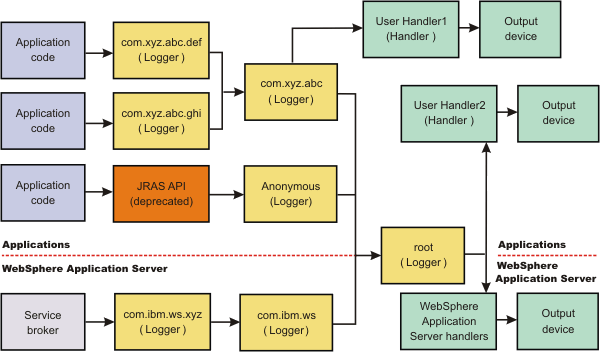Configure the logger hierarchy
WAS handlers are attached to the Java root logger, which is at the top of the logger hierarchy. As a result, any request from anywhere in the logger tree can be processed by WebSphere Application Server handlers.
Overview
You can configure your appserver to handle logs in many different ways. Configure your log settings based upon the configuration and the logging structure that best suits your needs.
Procedure
- Forward all application logging requests to the WebSphere Application
Server handlers. This behavior is the default.
- Forward all application logging requests to your own custom handlers.
Set the useParentHandlers option to false on one of your custom loggers, and then attach your handlers to that logger.
- Forward all application logging requests to both WebSphere Application
Server handlers, and your custom handlers, but do not forward WebSphere Application
Server logging requests to your custom handlers. Set the useParentHandlers option to true on one of your non-root custom loggers, and then attach your handlers to that logger.True is the default setting.
- Forward all WAS logging requests to both WAS handlers, and your custom handlers. Logging requests are always forwarded to WAS handlers. To forward WAS requests to your custom handlers, attach your custom handlers to the Java root logger, so that they are at the same level in the hierarchy as the WAS handlers.
Example
The following example shows how these requirements can be met using the Java logging infrastructure:

Use a logger
Creating log resource bundles and message files
Related Reference
Example: Creating custom log handlers with java.util.logging
Example: Creating custom filters with java.util.logging
Example: Creating custom formatters with java.util.logging
Example: Adding custom handlers, filters, and formatters